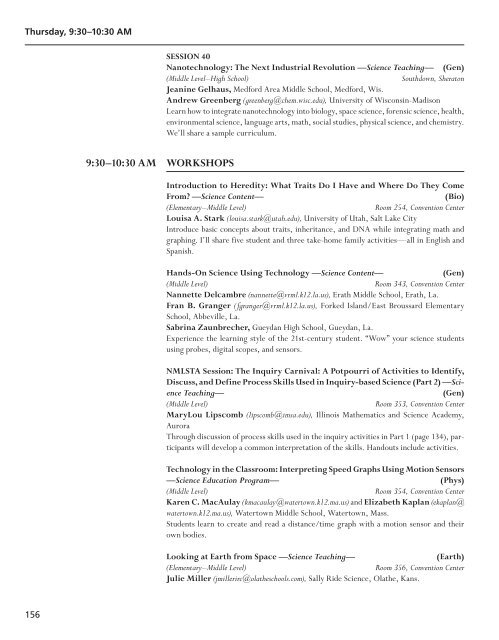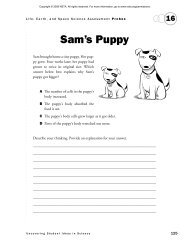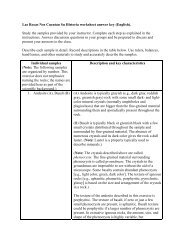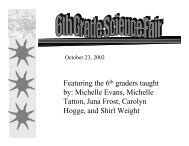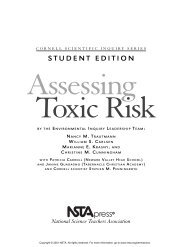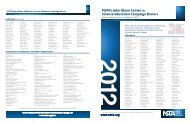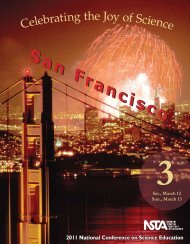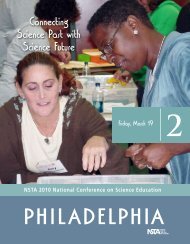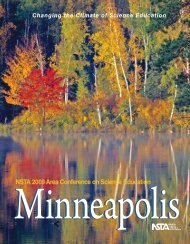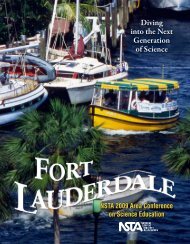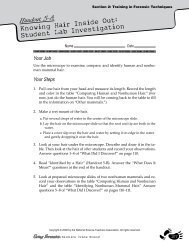New Orleans Program, Vol. 1 - National Science Teachers Association
New Orleans Program, Vol. 1 - National Science Teachers Association
New Orleans Program, Vol. 1 - National Science Teachers Association
You also want an ePaper? Increase the reach of your titles
YUMPU automatically turns print PDFs into web optimized ePapers that Google loves.
Thursday, 9:30–10:30 AM<br />
156<br />
9:30–10:30 AM WORKSHOPS<br />
SESSION 40<br />
Nanotechnology: The Next Industrial Revolution —<strong>Science</strong> Teaching— (Gen)<br />
(Middle Level–High School) Southdown, Sheraton<br />
Jeanine Gelhaus, Medford Area Middle School, Medford, Wis.<br />
Andrew Greenberg (greenberg@chem.wisc.edu), University of Wisconsin-Madison<br />
Learn how to integrate nanotechnology into biology, space science, forensic science, health,<br />
environmental science, language arts, math, social studies, physical science, and chemistry.<br />
We’ll share a sample curriculum.<br />
Introduction to Heredity: What Traits Do I Have and Where Do They Come<br />
From? —<strong>Science</strong> Content— (Bio)<br />
(Elementary–Middle Level) Room 254, Convention Center<br />
Louisa A. Stark (louisa.stark@utah.edu), University of Utah, Salt Lake City<br />
Introduce basic concepts about traits, inheritance, and DNA while integrating math and<br />
graphing. I’ll share five student and three take-home family activities—all in English and<br />
Spanish.<br />
Hands-On <strong>Science</strong> Using Technology —<strong>Science</strong> Content— (Gen)<br />
(Middle Level) Room 343, Convention Center<br />
Nannette Delcambre (nannette@vrml.k12.la.us), Erath Middle School, Erath, La.<br />
Fran B. Granger (fgranger@vrml.k12.la.us), Forked Island/East Broussard Elementary<br />
School, Abbeville, La.<br />
Sabrina Zaunbrecher, Gueydan High School, Gueydan, La.<br />
Experience the learning style of the 21st-century student. “Wow” your science students<br />
using probes, digital scopes, and sensors.<br />
NMLSTA Session: The Inquiry Carnival: A Potpourri of Activities to Identify,<br />
Discuss, and Define Process Skills Used in Inquiry-based <strong>Science</strong> (Part 2) —<strong>Science</strong><br />
Teaching— (Gen)<br />
(Middle Level) Room 353, Convention Center<br />
MaryLou Lipscomb (lipscomb@imsa.edu), Illinois Mathematics and <strong>Science</strong> Academy,<br />
Aurora<br />
Through discussion of process skills used in the inquiry activities in Part 1 (page 134), participants<br />
will develop a common interpretation of the skills. Handouts include activities.<br />
Technology in the Classroom: Interpreting Speed Graphs Using Motion Sensors<br />
—<strong>Science</strong> Education <strong>Program</strong>— (Phys)<br />
(Middle Level) Room 354, Convention Center<br />
Karen C. MacAulay (kmacaulay@watertown.k12.ma.us) and Elizabeth Kaplan (ekaplan@<br />
watertown.k12.ma.us), Watertown Middle School, Watertown, Mass.<br />
Students learn to create and read a distance/time graph with a motion sensor and their<br />
own bodies.<br />
Looking at Earth from Space —<strong>Science</strong> Teaching— (Earth)<br />
(Elementary–Middle Level) Room 356, Convention Center<br />
Julie Miller (jmillerirc@olatheschools.com), Sally Ride <strong>Science</strong>, Olathe, Kans.


